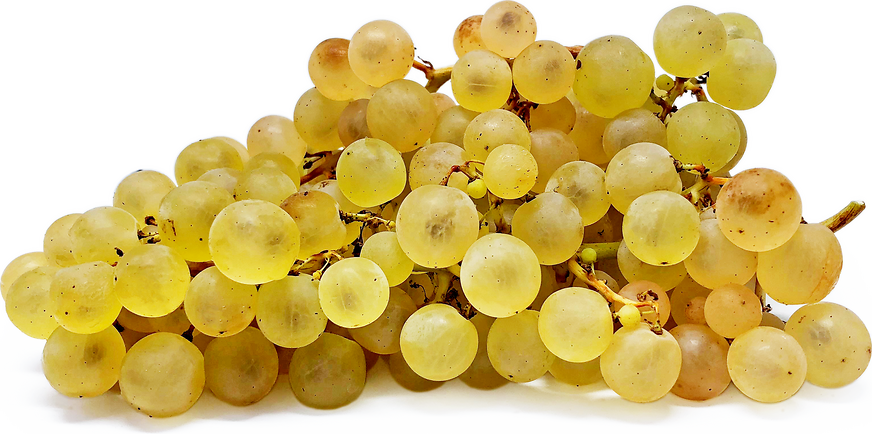


Mosaic Grapes
Estimated Inventory, lb : 0
Description/Taste
French Mosaic grapes are round, about the size of a large blueberry, and they grow in tightly packed clusters. They range in color from light green to golden yellow, with some sun-kissed maroon spots. French Mosaic grapes have thin and delicate skin, and contain a small seed in the center of their translucent green, juicy flesh. They come in high on the Brix scale at a 17, and offer a sweet taste of honey.
Seasons/Availability
French Mosaic grapes are available in early fall and through early winter.
Current Facts
Categorized as a white grape, French Mosaic grapes are considered a gourmet variety, highly distinguished as being one of the most prized and awarded grapes from France. There are more than 250 producers of French Mosaic grapes, and over 3,500 tons are harvested on average per year under the AOP and PDO. The Protected Designation of Origin (PDO) is a highly regarded classification in the European Union. It ensures that a product’s main stages of production are carried out according to a recognized standard, and in the same geographical area, which gives the product it’s distinct characteristics, therefore protecting the name and quality of the product.
Nutritional Value
French Mosaic grapes are an excellent source of vitamins C, K, B1 and B6, as well as minerals like potassium and manganese. They are also rich in flavonoids, which are important phytonutrients with antioxidants that benefit the immune system, and polyphenols, which are concentrated in the grape’s skin and act as additional antioxidants for the body.
Applications
French Mosaic grapes are best suited for raw consumption as their delicate, thin skin and honey-like taste make them enjoyable as a table grape. They are also used as a topping for desserts like fruit tarts, ice cream, or parfaits. In France, they are often used to make jams, candies, or even juice. These sweet grapes pair well with foods that are spicy, salty, sour, or bitter, including curries, cured meats, all kinds of cheeses, almonds and other roasted nuts, or even tart fruits like cranberries. French Mosaic grapes can be stored in the refrigerator loosely wrapped in plastic for up to 5 days.
Ethnic/Cultural Info
French Mosaic grapes were the first fresh fruit to be awarded the Appellation d’Origine Controlee (AOC) distinction by the National Institute of Appellations of Origin in 1971. Then, in 1996, Europe awarded these grapes the Protected Designation of Origin (PDO) award, which recognizes and awards the French Mosaic for its quality. With such designations, French Mosaic grapes are required to be packaged in specific containers in order to protect the product. In addition, the containers (either a wooden tray weighing 8 kg with a cluster separator, or a thick cardboard tray weighing 4kg) must be easily recognized on the shelves, with each package containing a sign, identification number, and signature of the AO, along with the commitment of each producer of these grapes.
Geography/History
The history of French Mosaic grapes dates back to the Middle Ages. It is said that the Abbey of Saint Pierre Moissac introduced grapes and viticulture in the Southwest of France at that time. There, in the province known as Bas Quercy, it was discovered that the hillside slopes facing south and southwest provided the perfect sunlight to grow these grapes. This geographical area extends over 76 municipalities in the departments of Tarn-et-Garonne and Lot, where the silico-clay, sandy, well-drained and decalcified soil also contributes to the perfect growing conditions for French Mosaic grapes.
Recipe Ideas
Recipes that include Mosaic Grapes. One
| The Hungry Bites |
|
Sweet Wine & Grape Tart with Easy Olive Oil Crust |
| The Gunny Sack |
|
Triple Grape Fruit Pizza |




